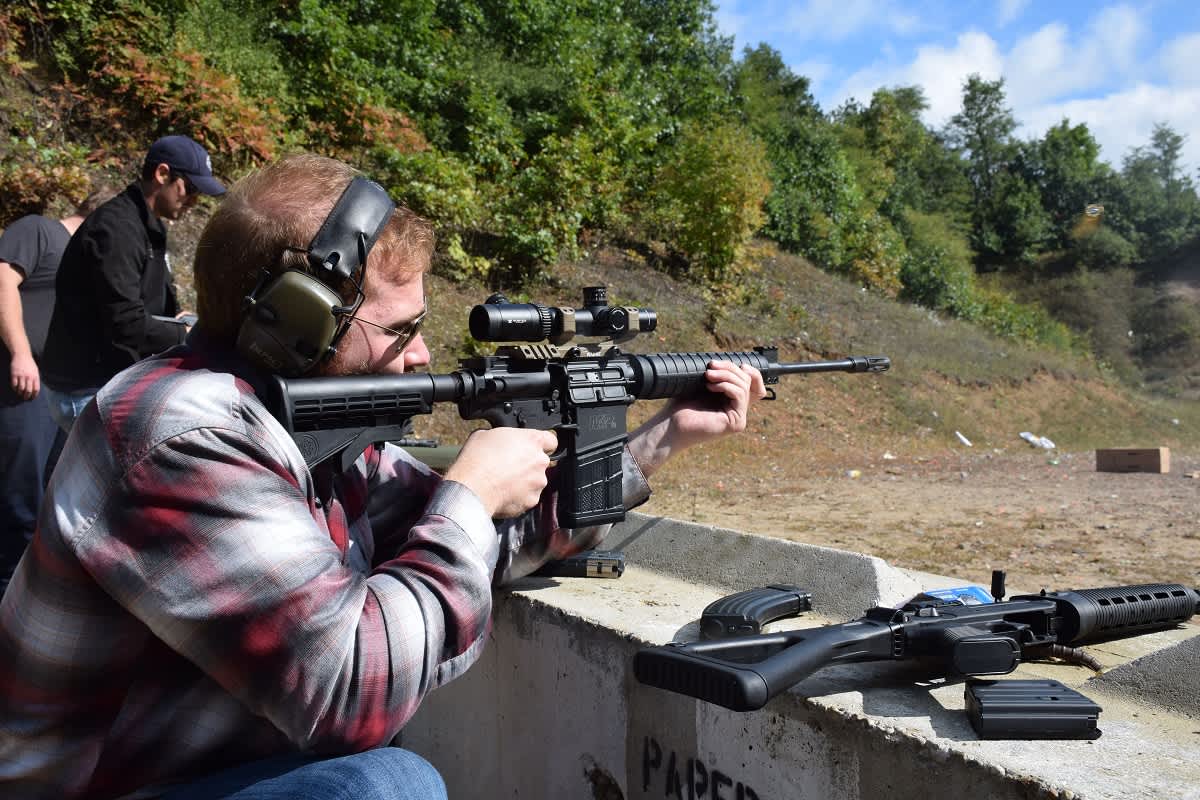Smith & Wesson M&P10 Rifle
Matt Korovesis 10.27.14

These days, AR-15 aficionados have a lot of options to choose from. Shooters looking to purchase modern versions of the classic design can choose from budget guns priced at $500 (and sometimes below) all the way up to premium precision rifles with four-digit price tags—and hundreds of other builds in between.
More gun companies have also begun to offer variants of the AR-10, Eugene Stoner’s .308 caliber predecessor of the AR-15. Smith & Wesson’s foray into this realm is the M&P10. I’ve been interested in the AR-10 platform for quite some time, so I contacted Smith & Wesson’s PR team a few months ago and requested one for testing. After shooting and handling it, here’s what I have to report.
It’s light
Most of the .308 battle rifles I’ve fired were G3- or FN FAL-pattern firearms—many of which fall in the over-nine-pounds-unloaded weight class. Prior to shooting the M&P10, the absolute lightest semiauto I’d shot in .308 was the Zastava M77, which weighs 8.6 pounds. The M&P10 clocks in almost a full pound lighter than that, at 7.7 pounds unloaded.

The first thought that crossed my mind when I picked up the M&P10 was “Oh boy, this is gonna be fun to shoot.” And it was.
Well, fun with a substantial amount of felt recoil. To be sure, the M&P10 isn’t uncontrollable by any means—it just kindly lets you know that you’re shooting it with a rather sharp and significant push. If you ever happen to pull the trigger without the gun properly shouldered, you’ll know it. The M4-style collapsible stock certainly doesn’t make shooting the M&P10 any more comfortable, and I’d recommend a bulkier replacement if you’re interested in doing anything with the gun other than occasional plinking. Piling on optics and other accessories will also make the gun a bit easier to shoot.

Notwithstanding the gun’s notable recoil, its light weight makes it quite easy to carry around for extended periods of time. It’d be perfect for the hunter seeking a portable and powerful autoloader.
It’s got the right features
The M&P10’s fire controls are fully ambidextrous. The bolt release, selector lever, and mag release can all be manipulated easily by right- or left-handed users. It has a flattop upper receiver and a railed gas block, which allow you to mount your optics and backup sights in the most effective manner for an AR.

Its midlength gas system is covered by a classic clamshell-style handguard that offers no frills, but is perfectly serviceable. Though it sports an 18-inch barrel, the gun is compact enough for a battle rifle at 37.6 inches with the stock collapsed, and 40.9 inches with it fully extended. It’s not high speed, low drag compact, but you won’t accidentally be putting holes in your ceiling with the muzzle.
Speaking of muzzles, the barrel on the M&P10 I tested was topped with a pretty mean-looking brake. Based on my shooting experience, I would not want to shoot it without that brake.
My test rifle was supplied with a 10-round metal magazine. The gun will accept any SR-25/DPMS pattern magazines. In addition to the provided mag, I used a Magpul PMAG 10 LR/SR and a pair of new Lancer L7AWMs throughout my evaluation of the M&P10. All of the magazines fed flawlessly, but the Lancers were by far my favorites. They’ve got lightweight polymer bodies and stainless steel feed lips, making them sturdier than your average plastic mag.

If you want to swap out the handguard, the M&P10 uses “low profile” DPMS-pattern forearms. Keep that in mind when you’re browsing MidwayUSA for replacements.
It’s accurate
The M&P10 has a thin-profile barrel with a 1:10-inch twist rate. The barrel is not chrome-lined, but according to Smith & Wesson features a “durable, corrosion-resistant finish.” Based on my experience with the gun, it’s quite accurate. I used two different scopes (a Vortex Viper PST 1-4×24 and a Steiner GS3 2-10×42) on the rifle during my evaluation.
For both function and accuracy testing, I used steel-cased Wolf 150-grain .308 FMJ, Federal American Eagle 168-grain 7.62x51mm OTM, Winchester 147-grain .308 FMJ, and Winchester 168-grain .308 HPBT. I did not encounter any issues with reliability, and I did not clean the M&P10 at all during my time with it. Group results were as follows:
| Bullet | Number of five-shot groups | Average group (inches at 100 yards) | Best group (inches at 100 yards) |
| Wolf 150-grain .308 FMJ | 10 | 2.75 | 2.5 |
| Federal 168-grain 7.62×51 OTM | 4 | 1.3 | 1.25 |
| Winchester 147-grain .308 FMJ | 5 | 1.4 | 1.1 |
| Winchester 168-grain .308 HPBT | 5 | 0.95 | 0.6 |
As indicated above, the 168-grain Winchester HPBT produced the best results. Three of the bullet holes in the tightest five-shot group were touching, while the remaining two shots were roughly a half-inch away from the three. The rifle’s trigger breaks at a little over six pounds, and has very little take-up.

I was very pleased with the M&P10’s groups—it performed as well as other .308 caliber battle rifles that weigh significantly more.
It’s a bit pricey
The MSRP of the M&P10 I tested is $1,619. If that’s what they were actually selling for, I’d say it was massively overpriced. However, they are available from a number of online retailers in the $1,200 to $1,300 range, which is on the high side of “fair” for a complete AR-10-pattern rifle.
It’s a blast
All in all, the Smith & Wesson M&P10 is a solid option for someone looking to purchase an accurate, well-made, and mostly-ambidextrous .308 caliber AR. Its light weight makes it an excellent platform for mounting some serious optics, without turning the gun into a bulky boat anchor.

